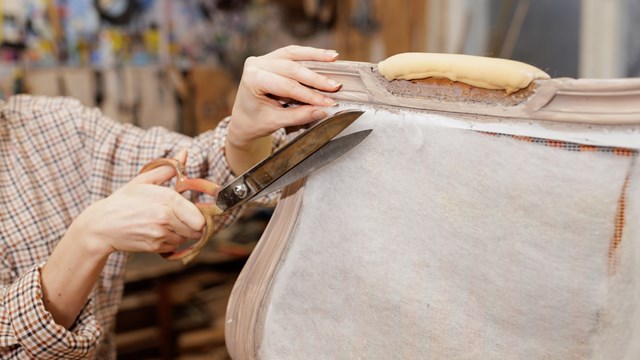Every member of a community association has a vested interest in the appearance of their property, both inside and out. Residents see the inside of their building every day, so it matters that it’s visually appealing. Equally importantly, they have a large financial stake in their unit, and the aesthetic quality of the surrounding common spaces adds value to the unit itself.
But when it comes to making decisions about how those shared common spaces are to be decorated, there is such a thing as too many cooks spoiling the broth. For this reason – and to keep remodeling and renovation projects focused on time and within budget – some associations choose to establish a separate design committee to helm projects and guide them through completion. Design committees usually consist of members with some experience in the field, or who just have a keen eye for color, décor, and what makes a space appeal to a broad array of tastes. These committees work with the board, management, residents and outside vendors to make the design choices for the building, and can occasionally command a portion of the association budget. So it makes sense to establish a transparent process by which decisions are made, resources allocated, and experts consulted.
Managing a Committee
While they may have a fair amount of latitude when making decisions, separate committees within an association are still under the supervision of the board and management. As such, managers can help steer a committee in the right direction, and jump in to pump the brakes if things start to drift out of bounds.
“Using a committee – or a commission, as they’re often referred to in Chicago – is a very common way of considering interior decorating recommendations and holiday decorations,” says Richard Hiles, Regional Director with Lieberman Management Services, which has offices in Chicago and Elk Grove Village, Illinois. “It’s a great way to engage a small amount of owners to make recommendations outside of the board.”
“In my experience, the board may call their support groups ‘committees,’ but in reality they are commissions, which have no authority to disburse funds,” adds Claudia Oberthier, Regional Director with Associa Chicagoland in Schaumburg, Illinois. “The commission meets with vendors, basically doing all of the research, and then presents any proposals to the board for approval during a board meeting. The manager is the liaison between the commission and the board. I always recommend that the fewer people involved with choosing colors and themes, the better. And, should there be a designer on hand, the board should absolutely listen to that professional’s recommendations.”
It helps to have a specific charter that delineates a design committee’s scope of responsibility as approved by the board. “If the board-approved scope is only carpet, paint, or adding or replacing furniture, those recommendations can usually be handled internally without outside help,” notes Hiles. “If the scope of work involves an entirely new aesthetic or a remodel, then the committee should engage several designers and recommend their best options to the board. Unfortunately, there is no clear threshold as to when one should hire a designer. Several factors must be considered before making that choice.
“Interior design is an aspect of our industry where you must start off with the mindset that you cannot please everyone,” Hiles continues. “Someone is going to hate whatever it is that you do! A committee should offer its recommendations to the board, and the board should make the final decision. That being said, mock-up designs are often displayed to owners at annual meetings and other special gatherings for public comment. While ultimately the decision belongs to the board, it is always good to get a general feeling from the membership.”
Committees in Collaboration
Hugh Shaffer, General Manager at Harbor Towers in Boston, is currently finishing up a lobby renovation project that involved the input of a commercial architectural firm working alongside the association’s design committee.
“[The architectural firm] met with our trustees and came up with various suggestions,” Shaffer recalls. “For this project, we went down to a design center and looked through their facility, sat on couches, put our feet up on ottomans... just tested things for comfort. Based on that experience, the architects suggested types of furniture that might be appropriate for our lobby. They also put together plans and specs for wall coverings – we eventually went with Italian marble. But the firm basically led all of the discussions.
“We asked them, as a committee and managing agent, to prepare presentation boards for the residents,” he continues. “We then had a meeting of all the residents in which we discussed the planned renovations and gave them an opportunity to offer feedback and input, which actually had a clear effect on some of the things the vendor was going to do.
“One issue that we did have – if there’s one learning curve aspect of this that I can impart – is that we found out a good way into the project that some of the furniture we’d picked out was not up to the standard fire code, based on the type of fire systems we have in this particular property,” Shaffer adds. “So you have to make sure that everything you acquire is up to local and national ordinances.”
The Design Side
Architects, interior designers, and other relevant professionals have all dealt with their fair share of community association design committees, for better or worse. As such, they’ve developed best practices for how to collaborate with an association’s internal team most effectively.
“I’ve worked with numerous community association boards, and it’s been a mixed bag,” says Wayne Turett, Principal of The Turett Collaborative in New York City. “Some treat you with respect, and some assume that you are out to ruin their lives. Admittedly architects at large are not a homogeneous group; some are sensitive to the broader context of things, while others are not. I think that you have to treat [design committees] with respect if you want to get respect. Listen to their concerns, and try to have a dialog – which isn’t always easy in the short time that you have to present. It also isn’t helpful that clients aren’t always sensitive, and will often put their own interests in front of the greater good. I know that I try to impress upon my clients that there isn’t just one way to get them what they want, and sometimes they listen.”
“Design by committee can water everything down, and you may end up with the most boring option,” warns Summer Thornton, Principal and and interior designer with Summer Thornton Design in Chicago. “The best thing to do is empower a couple of people on a board to make the decisions. The end result of 10 people with varying viewpoints voicing their opinions is that your building could look generic and boring, instead of highlighting how beautiful it could be; and that doesn’t bode well for resale, or the owners’ enjoyment of the space.
“If the whole board wants to be involved, let them be involved in the approval of which design firms to interview,” she continues. “After that, try to cull down the participants to a smaller group to select the firm, and then empower one or two people to approve the vision/concept from the design firm selected. The entire board should not be involved in the details of the design, or specific fabrics, or paint colors. To help the board trust their peers, the best thing to do is align on an overall vision first, wherein the board comes to consensus on a broader concept or mood. Then, when specific choices are made, they can be run by a smaller audience so that there’s more focus and fewer opinions that only muddy the waters.”
“I’d advise committees to have crystal-clear parameters for the project from the board, and provide these to the designer, including things like budget, priorities, elements that need to be retained, etc.,” suggests Jana Manning, Principal of Manning Design Group in Asbury Park, New Jersey. “The committee should be sure to have a clear process for reaching consensus. This is critical to ensuring that the designer receives timely and reliable input. Inspiration images proposed by the various committee members must be edited by the committee before being passed to the designer as reliable insight from committee preferences. Also, the designer should have one primary contact – usually the property manager – and there should not be any other unofficial communication with other members.”
Sensible delegation of tasks and projects is one of the best things boards can do – not only to reduce the sheer amount of work they have to do alongside their regular jobs and obligations, but to get non-board residents involved and engaged with their building or community association. While the old adage about not being able to please everyone goes double for anything aesthetic-related, smart use of a design committee can help make sure your residents feel heard when it comes to the look and feel of their common spaces.
Mike Odenthal is a staff writer/reporter with The Cooperator.










Leave a Comment